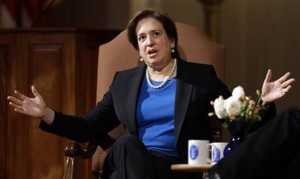WASHINGTON (AP) — President Barack Obama’s health overhaul remains an all-consuming drama for many, even though millions of people are gaining insurance coverage through a law that’s now 5 years old.
During oral arguments last week in the latest Supreme Court case brought by the law’s opponents, Justice Elena Kagan called it a “never-ending saga.”
Five reasons why the “Obamacare” epic plays on:
POLITICAL OPPOSITION
Unyielding opposition from conservative voters has made it practically impossible for Republican lawmakers to take a pragmatic approach to a program with obvious flaws, but also popular aspects.
Few in the United States want to go back to the days when insurance companies could deny coverage to people with pre-existing health conditions. But Republicans have followed a political game plan that requires them to first repeal Obama’s law before trying to replace it with legislation of their own, presumably to accomplish similar goals.
A Supreme Court ruling invalidating the law’s subsidies in most states would give Republicans their best opening yet. But any “replacement” legislation also would spend taxpayer dollars and spawn new federal regulations.
When former GOP President George W. Bush pushed through new Medicare prescription drug coverage, most Democrats opposed him, and some even called for repeal. Yet they also helped constituents navigate the new program.
Some Republican governors have risked a backlash from the party’s political base by accepting the law’s Medicaid expansion for low-income people. Still, Republicans in Congress remain a wall of opposition.
___
ADMINISTRATION STUMBLES
The president who once said you could keep your health plan if you liked it was caught flat-footed by a wave of insurance cancellations blamed on health law requirements taking effect in 2014.
The HealthCare.gov website, talked up as the equivalent of Amazon and Travelocity, broke down the day it was launched in 2013, and took months to patch up.
That same year, the administration announced the delay of a major requirement affecting employers on an obscure government blog just days before the Fourth of July.
This year, HealthCare.gov sent the wrong tax information to about 800,000 people, and an online insurance market geared to small businesses has disappointed.
The administration keeps resupplying the law’s critics with ammunition.
___
UNCONVENTIONAL PATH TO PASSAGE
The Affordable Care Act did not get the legislative equivalent of close editing by a House-Senate conference committee.
Congressional committees worked on different pieces of the bill and the complete package was assembled in negotiations shepherded by leadership.
That could have made it more likely that glitches would get baked into the 900-plus pages of the law.
Problems emerged soon after the law was signed. Vague wording of a provision guaranteeing coverage to children with pre-existing health conditions was cleaned up through regulations after the insurance industry acquiesced.
The path to passage may be at the root cause of the current dispute before the Supreme Court, which centers on whether the wording of the law allows federal subsidies in states that don’t set up their own insurance markets.
“It was pushed through on expedited procedures and didn’t have the kind of consideration by a conference committee … that statutes usually do,” noted Justice Antonin Scalia.
___
COSTS OF CARE
Although premiums are heavily subsidized, people who buy private coverage through the law’s new insurance markets may still struggle with costs.
Out-of-pocket expenses, including the annual deductible and required copayments, can be as high as $6,600 for an individual and $13,200 for a family.
Faced with a serious illness, a family making $60,000 a year might have to shell out more than 20 percent of its income. That’s on top of living expenses.
Average monthly premiums rose by 8 percent this year in the states served by HealthCare.gov., according to preliminary administration data.
After subsidies, the average monthly premium that consumers pay directly rose by $23 a month.
___
IT’S DARN COMPLICATED
Obama’s law joined two of the most complicated areas for consumers: health insurance and taxes.
Even now, in the second year of coverage, enrollment counselors say many consumers get overwhelmed trying to understand what plan is best for them. It can be hard to figure out which doctors are in what plans, and what is the patient’s share of the cost for a particular medication.
This tax filing season will reveal the connections between the law and the tax system, which is used to deliver carrots and sticks.
Premiums subsidies are packaged as tax credits and consumers will have to account to the IRS that they got the right amount. People who remained uninsured will see fines deducted from their tax refunds, if they’re deemed able to afford coverage.
If the last five years are a guide, look for more surprises as the saga continues.




